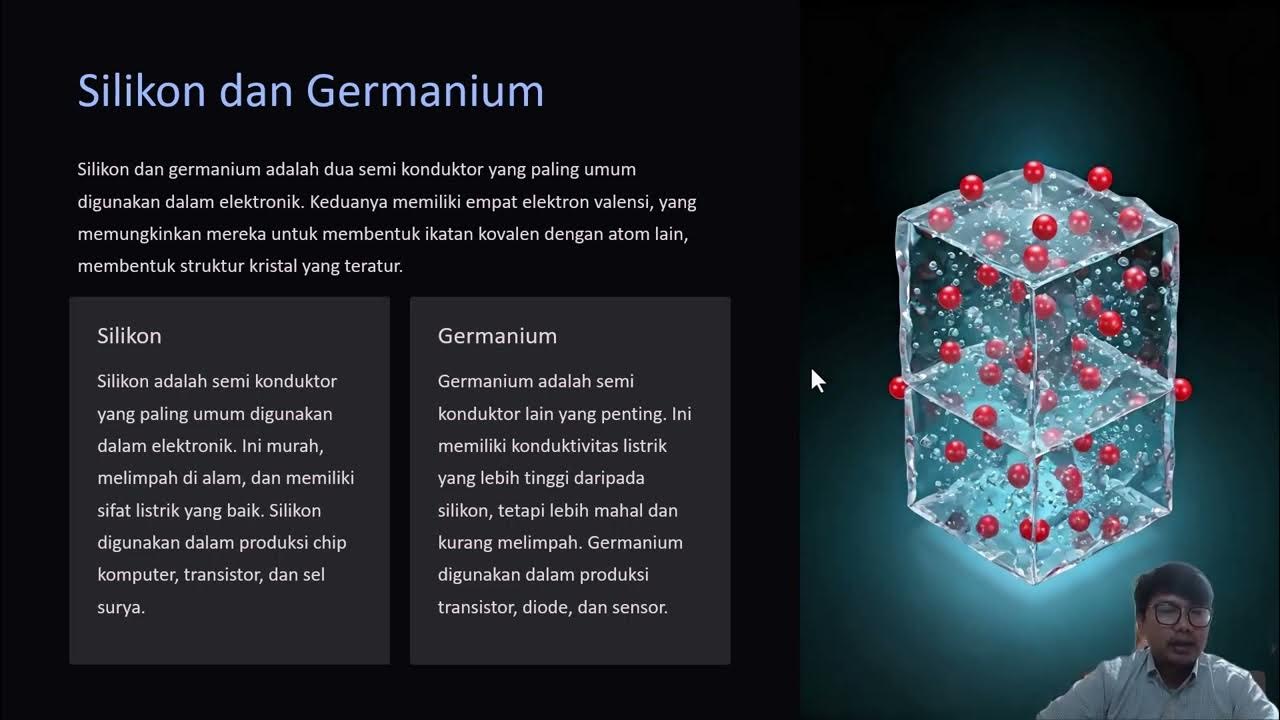Classification of Semiconductors (Intrinsic/Extrinsic, P-Type/N-Type)
Summary
TLDRThis video covers the fundamentals of semiconductors, their role in electronics, and the transition from vacuum tubes to semiconductor devices like transistors. It explains how semiconductors, such as silicon, are materials with conductivity between conductors and insulators. The video introduces intrinsic semiconductors and how doping them with impurities can enhance their conductivity, creating either n-type or p-type semiconductors. The formation of a p-n junction, essential for devices like diodes and transistors, is also discussed. Viewers are invited to learn more and engage by asking questions or subscribing.
Takeaways
- 🔌 Vacuum tubes were used for signal amplification and switching before semiconductors, but they were bulky and inefficient.
- 💡 Semiconductors became dominant in electronics after the invention of transistors, which are much more efficient than vacuum tubes.
- 🔋 Semiconductors fall between conductors and insulators in their ability to conduct electrical current.
- 💻 Silicon is the most widely used semiconductor material, followed by gallium arsenide.
- 🌡️ Germanium was initially used in semiconductors but was phased out due to its instability at high temperatures.
- ⚡ In intrinsic semiconductors, free electrons and holes are generated when thermal energy allows electrons to move from the valence band to the conduction band.
- 🔧 Doping a semiconductor by adding impurities increases its conductivity by introducing more current carriers like free electrons or holes.
- ⚙️ N-type semiconductors are created by doping with pentavalent atoms, which increase free electrons as the primary current carriers.
- 🔨 P-type semiconductors are made by doping with trivalent atoms, which increase the number of holes as the primary current carriers.
- 🔗 The p-n junction, formed where p-type and n-type semiconductors meet, is the foundation for semiconductor devices like diodes, transistors, and thyristors.
Q & A
What were the limitations of vacuum tubes that led to the development of semiconductor devices?
-Vacuum tubes were bulky, required high operating voltage, and were inefficient, which led to the development of semiconductor devices like transistors.
What are semiconductors and why are they important in electronics?
-Semiconductors are materials that have conductivity between conductors and insulators, making them ideal for controlling electrical current in electronic devices.
What are the most commonly used semiconductor materials in the electronics industry?
-The most commonly used semiconductor materials are silicon and gallium arsenide. Germanium was used in the early years but became less popular due to its instability at high temperatures.
What are free electrons and holes in a semiconductor material?
-Free electrons are negatively charged particles in the conduction band, while holes are positive vacancies left in the valence band when electrons move to the conduction band.
Why do intrinsic semiconductors have poor conductivity?
-Intrinsic semiconductors have poor conductivity because they have a limited number of free electrons and holes, which restricts the flow of current.
How does doping improve the conductivity of a semiconductor?
-Doping improves conductivity by adding impurities to an intrinsic semiconductor, increasing the number of free electrons or holes, which enhances the flow of current.
What is an n-type semiconductor?
-An n-type semiconductor is created by doping an intrinsic semiconductor with pentavalent atoms, which increases the number of free electrons and enhances conductivity.
What is a p-type semiconductor and how is it created?
-A p-type semiconductor is formed by doping an intrinsic semiconductor with trivalent atoms, which increases the number of holes and improves its conductivity.
What is a p-n junction, and why is it important in semiconductor devices?
-A p-n junction is the boundary where p-type and n-type materials meet. It is crucial because it forms the basis for devices like diodes, transistors, and thyristors.
What role do semiconductors play in modern electronic devices?
-Semiconductors are essential in modern electronics, enabling devices like transistors, diodes, and integrated circuits, which are used for signal amplification, switching, and power regulation.
Outlines

This section is available to paid users only. Please upgrade to access this part.
Upgrade NowMindmap

This section is available to paid users only. Please upgrade to access this part.
Upgrade NowKeywords

This section is available to paid users only. Please upgrade to access this part.
Upgrade NowHighlights

This section is available to paid users only. Please upgrade to access this part.
Upgrade NowTranscripts

This section is available to paid users only. Please upgrade to access this part.
Upgrade NowBrowse More Related Video

How do semiconductors work? (with animation) | Intermediate Electronics

Semiconductors - Physics inside Transistors and Diodes

Semiconductors, Insulators & Conductors, Basic Introduction, N type vs P type Semiconductor

What is Electronics | Introduction to Electronics | Electronic Devices & Circuits

Pengantar Semi Konduktor

A PEÇA que ENCOLHEU o COMPUTADOR! #SagaDosComputadores Ep. 5
5.0 / 5 (0 votes)